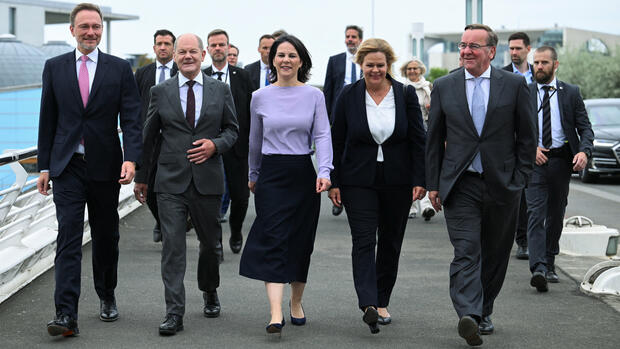An unusually large number of cabinet members are present at the presentation of the foreign and security policy policy paper in Berlin.
(Photo: Reuters)
Berlin The federal government today adopted a national security strategy for the first time in the history of the Federal Republic. An unusually large number of cabinet members are present at the presentation of the foreign and security policy policy paper in Berlin.
In addition to Chancellor Olaf Scholz, the following are present: Foreign Minister Annalena Baerbock, who was in charge of the strategy, Finance Minister Christian Lindner, Interior Minister Nancy Faeser and Defense Minister Boris Pistorius.
As can be seen from an initial overview paper sent out by the Federal Press Office this morning, the Federal Government has “analyzed our security environment in a systematic overall approach based on a broad concept of security and derived concrete measures and follow-up projects from this”. The “turning point” proclaimed by Scholz last year was a determining factor, the paper says.
The strategy follows the principle of “integrated security,” said Chancellor Scholz. It is not just about defence, but also about diplomacy, development and the resilience of supply chains. All of these parts would have to “interlock”, according to Scholz.
As previously announced, the long-awaited policy document also enshrines the two percent target for arms spending in Germany agreed with NATO.
The strategy is also about strengthening the resilience of the economy, as the Handelsblatt had previously reported. The overview paper states: “We are reducing one-sided dependencies in the supply of raw materials and energy by diversifying our supply relationship”.
In addition, raw material projects are to be specifically promoted “together with industry”, for example for strategic warehousing. Providers of key technologies should also be given special support, for example through anchor orders.
There were disagreements in the process
The plan was actually to present the strategy at the Munich Security Conference in mid-February. In the coalition agreement, the governing parties agreed to adopt the strategy in the first year of the legislative period. But again and again there was disagreement about what should actually be in it.
In the course of the process, the traffic light rejected the idea of a National Security Council because the Chancellery and Foreign Ministry could not agree on the design. Recently there had been disagreements about the wording of the possibility of so-called hack-backs, i.e. targeted counterattacks in the event of cyber attacks, where the FDP had expressed concerns. However, the coalition partners sensed that this was purely a delaying tactic, with which the FDP wanted to damage the reputation of Foreign Minister Baerbock.
In the end there were many compromises, in some places the traffic light parties had no choice but to fall back on the coalition agreement – that is, on what had already been agreed.
In the next few weeks, the China strategy be decided, it is subordinate to the national security strategy and should serve as a guide for dealing with the autocratic state. According to information from the Handelsblatt, the federal government is aiming for completion by after the summer break.
More: Interview with tech expert Wang – “The EU doesn’t have the brutal, bloodthirsty mentality that China and the US have”
